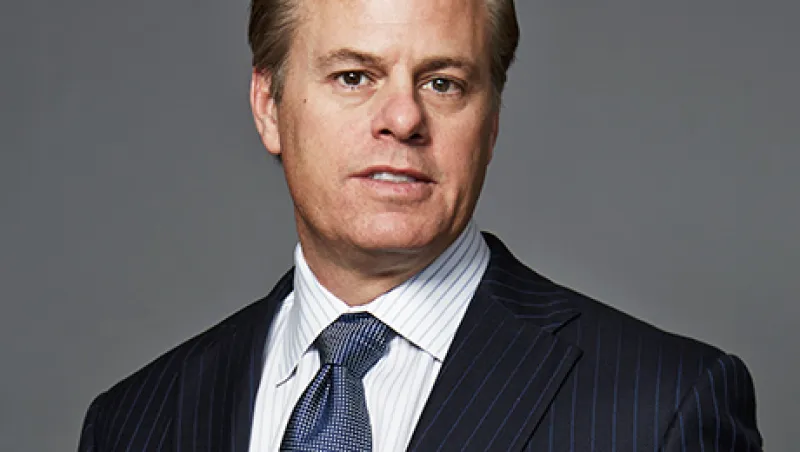Michael Gregoire looks at big changes in technology as an opportunity to rethink what he is doing. The Canadian native, who learned programming in high school on an Apple PC, spent the first 12 years of his career at Electronic Data Systems, the Plano, Texas–based company founded by Ross Perot to manage information technology for large corporations. By 2000, Gregoire was running EDS’s financial services information solutions group, and he saw that its core custom-built-applications business was being threatened by off-the-shelf software packages created by enterprise-resource-planning companies like SAP and PeopleSoft.
“All of those companies were just exploding,” says Gregoire, 48, who has a BS in physics from Wilfrid Laurier University in Waterloo, Ontario, and an MBA from Santa Ana’s California Coast University. “The value proposition was that you didn’t have to write something from scratch. I felt the world was moving away from bespoke applications.”
Gregoire joined PeopleSoft in May 2000 as a senior vice president in its consulting division. When software giant Oracle Corp. agreed to buy PeopleSoft in December 2004 in a $10.3 billion hostile takeover, Gregoire was managing an army of more than 4,000 professionals worldwide and had helped the company double its revenue. He decided not to go with Oracle. Three months later he became CEO of Taleo Corp., a privately held software maker specializing in workforce recruitment. He took Dublin, California–based Taleo public in October 2005 and expanded its talent management suite of products, offering software as a service (SaaS) to customers on a hosted platform. “The whole concept of SaaS was very, very new,” Gregoire says.
In February 2012, Oracle agreed to buy Taleo for $1.9 billion — “through a very friendly sale,” Gregoire notes — and Gregoire was once again out of a job. That summer he started talking to the board of CA Technologies, which had been founded as Computer Associates in 1976 by Charles Wang and Russell Artzt to provide software for IBM mainframe computers. CA Technologies had changed its name in 2010 to reflect “the full breadth and depth” of its business, spanning mainframes, distributed computing platforms and cloud computing. The Islandia, New York–based company’s software and services help customers manage and secure their IT applications and infrastructure.
Since Gregoire became CEO in January 2013, CA Technologies has generated an average of $1.15 billion in revenue each quarter, with about half of that coming from its mainframe business. He plans to increase revenue by focusing on innovative new products, especially software that can be delivered on demand as a service. An avid cyclist who is signed up to compete in California’s 129-mile Death Ride in July, Gregoire recently met with Institutional Investor Editor Michael Peltz at CA Technologies’ New York City offices to discuss his first year as CEO and his plans for growing his company.
Institutional Investor: Could you have gone to work for Oracle after it acquired Taleo?
Gregoire: Yeah, I think so. [But] once you’ve been a public company CEO — if I wanted to work again, I’d want to work in that kind of context, in that environment, and I wasn’t sure I wanted to go back and have a big operational role. I thought I’d do some board work, do some angel investing and kind of just be in and around the intelligentsia of [Silicon] Valley — help young, first-time CEOs on how to scale a company, how to work with a board, how to make the right decisions between go-to-market and R&D and innovation. And I thought that would be rewarding and enlightening to me. And what I found was, I just had this yearning to lead and to run a business and to be in the game.
Why CA Technologies?
It’s a company that shouldn’t settle for second-best. They should be able to get whatever they want. And the strategy that they had was to try to get this company that’s got a great franchise, spends $660 million on R&D, has global distribution, mission-critical application capabilities, a customer list that’s to die for, superstrong relationships in the Fortune 500 — how do you take all of these assets and turn it into a modern software company that’s kicking out new innovation on a regular basis?
{BrightcoveVideo}
You didn’t mind moving from California to New York?
Oh, I minded very much. But at the end of the day, it was absolutely the right thing to do. To go do this job, you have to be 100 percent committed. And if I was living in California, I’m not sure the employee base would believe that I was here for the long haul, and I was here and committed to going and making this happen. When you [move with] two 14-year-old children that have a great life and 290 days of sunshine, that’s a big commitment.
How do you attract top engineers and software programmers to CA’s headquarters on Long Island? It’s not exactly Silicon Valley.
We have six major hubs that do pure R&D and innovation, [Long Island] being one of them. But if you think of the places that we’re in, they’re exactly where you’d want us to be. One of the first things I did is, I opened up the Silicon Valley research center, which is right in the heart of the valley. We have about 500 people there; it’s right on [Highway] 101, big signage. And that’s a place where we’re doing a lot of innovation. A lot of our mobile technology’s being built out of there. Austin, Texas, is another place that is just a hotbed for great engineering talent. We are in Framingham, outside Boston. There’s no shortage of great talent there. We do a lot of our mainframe development in Prague, and I think the average age of an engineer there working on the mainframe is under 30. We also have our own center in India: We have about 2,800 people in Hyderabad and Bangalore. So we are able to attract talent because we’re in the right places. And the best engineers, they want to work with and for great leaders, they want to work on the most interesting things, and they want to win. And if you can provide an environment like that, I think you have an opportunity to attract the best resources.
How do mainframes fit into your business?
The mainframe is still an important part of our story, and we’re one of the only companies, next to IBM, that’s still investing in the mainframe. But we’re trying to modernize the platform. For example, we have a product called Chorus that allows you to manage mainframes using a graphical user interface. Nobody has anything that sophisticated to manage a mainframe on the market.
Second, we’re trying to bring modern infrastructure awareness to the mainframe. There’s a product we have called Vtape. Instead of putting a backup onto a tape — you know, a magnetic tape — and having to cart it off-site, you hit another button and we automatically stream that to AWS [Amazon Web Services]. For a penny a terabyte, you could have your data highly secured, coming off your mainframe, streaming to a hard disc up in a public cloud. You know, these are the kind of concepts from an innovation point of view that we’re bringing to bear.
Revenue has been largely flat since your arrival. How will you grow it?
Well, this is the whole innovation message. We have a couple things that are unique to the CA story. One, we have this franchise in the mainframe that’s about half of our revenue, and it’s mission-critical work, but that’s a platform that’s just not growing. So the whole idea there is to add enough value and add enough innovation that the current customers you have take advantage of it and feel that they’re getting value, and they’re willing to pay for that.
Now, when you have something that big that’s decreasing a little bit, that puts a lot of pressure on the other half of the business, which is the area that you want to grow. So when you start the year off, you have to make up for what’s going down in your legacy platform, which is just the natural evolution of technology. So your net new ideas have got to be pretty spectacular. And I would say that our track record of getting the big ideas growing as fast as the revenue decreasing on the mainframe, that’s the problem that we have to crack, and there are only really two ways of doing that. No. 1 is, have highly innovative products that the market wants, and those products are going to be easy to use, easy to install, easy to maintain and easy to sell. When you take a look at how we’re spending our R&D dollars, it’s all along those themes. And we’ve got a number of SaaS-oriented products — we have seven of them in the market today — and all of those are growing in very high double digits.
Second, we have to be very smart about the acquisitions we bring in. Acquisitions are a tool, but I think the company spent a little bit too much time on them and kind of got away from the first thing of being a great software company, being able to build software from scratch and build out our own net new ideas with input from customers. So we’re trying to balance the two: Use acquisitions when they’re appropriate, but clearly have a focus on organic engineering.
Do you have a good example of an innovative product you’ve come out with recently?
We just launched a product called Nimsoft Monitor Snap. I think it startled a number of people. In the same way that you could go download an application from the iTunes store or the Google Android store, you can go to our website and download a very sophisticated monitoring tool that’ll allow you to monitor up to 30 devices for free. Primarily, you’d be monitoring servers, network storage equipment, disc drives. Now, this is software that eight to ten years ago would have cost a million dollars and taken six months to implement; it takes 45 minutes to implement. And the whole idea here is easy to use, easy to sell, easy to understand, and our view is, if companies see what we really can do, they’ll be willing to engage with us on a subscription or a license to do more.
Are you looking to expand your client base?
Absolutely. As I said before, we have done a fabulous job for the Fortune 500, or even the Global 500. There’s not one of those companies that’s not running CA software, and it’s running mission-critical software, whether it’s on the mainframe, distributed or in the cloud. But one of the beauties of the cloud is, it democratizes technology — in the same way that Nimsoft Monitor Snap ten years ago would have cost a million dollars and taken six months to implement. If you’re a smaller company — $300 million to $2 billion in revenue — there’s no reason why you shouldn’t have great technology. And we have this great technology that’s been running the biggest corporations in the world for years, making it easier to use, easier to install, less expensive to run ... driving into that space. That’s net new growth for us. And that’s a very important market, and I think that we have to do more to make sure that we get into that market.
What does cloud computing mean for the future of the mainframe?
Well, I think it’s just another tool. If you take a look at how IBM’s positioning the mainframe, first of all, they don’t use the word “mainframe” anymore. They just look upon it as another server in the cloud. That’s good for us because that platform, if it’s modernized and used appropriately with the right price point, I think it just becomes another tool in the arsenal of a business professional. CA has built a very rich 37-year history on being a heterogeneous provider of three things: security, infrastructure management and application management. So for us it’s more important to have the best products on the mainframe, distributed and in the cloud, because the workload’s going to be in one of those three environments, and we want to be part of that story regardless of which particular platform a customer wants to run their workload on.
What does “big data” mean for CA?
It means two things. First of all, there’s security, application management and infrastructure management of the environment and platforms that run big data. All of them have to be secure; there’s going to be applications that run on them; and the actual hardware that is used — the infrastructure — and how it participates in the overall enterprise need to be monitored. So there’s a whole side of our business that takes care of that for big data.
And then the really interesting story, I think, is: What do we do with all of the data that we have? I think we’re early, early days on that, but there’s a lot of information that we’re collecting, both on the infrastructure management side as well as on the development side. We have a number of data scientists that work out of our San Diego office, and their job is to take a look at this data and try to understand how we can take this data and turn it into a product or provide some level of value back to our customers. And I think the story’s still untold on that for CA, but this is definitely something that we’re working on in the labs.
What would you do with the data?
Primarily, predictive analytics. You know, one of the things you always want to do is, you want to intercept something before it fails. Any time you can get somebody a little bit of predictive intelligence about how their applications are running or how their infrastructure’s running, so that you don’t experience downtime, that’s incredibly valuable. • •
Get more from Gregoire in his video interview, “Striking a Balance Between Growth and Innovation.”






